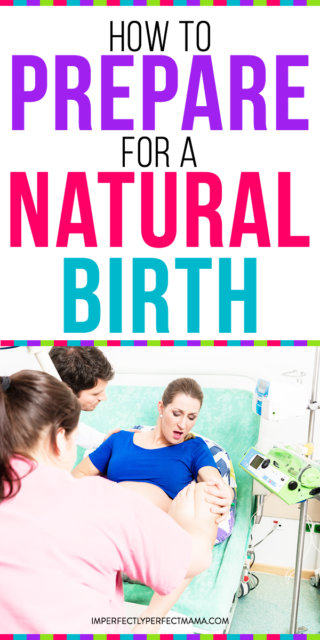Currently expecting and hoping for a natural birth?

In search of some of the best tips and tricks to help you avoid interventions and make your dream delivery possible?
Natural birth has many benefits to both mom and baby.
It can help you have a shorter labor, quicker postpartum recovery, and allow you to present during your birth.
Your baby will be less likely to go into fetal distress and more likely to breastfeed right after delivery. Plus, natural birth is usually much cheaper!
But natural birth doesn’t often come easy.
Especially, if you’re in a hospital setting with pain meds available right at your finger tips.
Natural births usually require lots of planning, training, and education for the big day. And, it takes a ton physical of mental strength.
So, what exactly should you do to prepare yourself for giving birth naturally?
In this post, we’ll cover 9 of the best ways to help prep your mind, body, and soul for a natural birth.
1. Choose a Midwife Over an OB
Your first step to having a natural birth is finding a care team that is supportive of your intentions to avoid interventions.
And, statistically speaking, you’re much more likely to have a natural birth with a midwife than an OB.
Recent research has associated midwifery care with significantly lower rates of c-section, episiotomy, and use of pitocin, and higher rates of breastfeeding success and satisfaction with care during pregnancy and birth.
If you decide to have a home birth or use a birthing center, you’ll almost always be using a midwife.
But, there’s also many hospitals now that have affiliated midwife groups.
Of course, a midwife may not be a feasible option if you’re high-risk or just don’t have any available in your area.
But, no matter which route you go, just be sure to interview a few providers before landing on a decision.
And remember, it’s never too late to switch. If you’re not feeling comfortable towards the end of your pregnancy, don’t be afraid to reach out to other midwives or OBs.
2. Take a Natural Childbirth Class
By taking a childbirth class that’s geared towards natural birth, you can have the knowledge, confidence, and preparation to support your decision in avoiding interventions. You’ll learn about varying birthing positions, the different stages of labor, and the benefits of having a natural birth.
Plus, your partner will learn how they can best support you during the birth process.
Unlike most hospital-based classes that basically just teach you how to be a good patient, natural courses are usually much more extensive and will spend a good amount of time covering breastfeeding, educating on what’s normal for a natural birth, and just providing support and encouragement.
If you don’t have a natural childbirth class in your area, there are plenty of online courses you could enroll in.
You could also invest in some helpful books, like by Ina May’s Guide to Childbirth or The Birth Partner.
3. Know Your Natural Pain Management Options
This is a big one mamas!
And while your natural childbirth class may cover this, you need to be fully aware of the tools that are available to help you manage your pain without an epidural.
It’s not a bad idea to practice these coping techniques as much as you can during your pregnancy and have a list written down to help you remember them while you’re in labor.
Many moms find breathing techniques, self-hypnosis, and massage to be effective for the pain, but you never know what you’ll want until you’re actually in labor. You may find yourself not wanting to be touched at all.
You may have planned on laboring in the tub, but then finding yourself wanting absolutely nothing to do with it when the time comes.
4. Get Familiar With Transition
When transition hits, things really start to ramp up.
This is the most intense, but also the shortest part of labor.
Many moms aren’t aware that they’re in transition, and they become vulnerable and may end up asking for pain medication, which they didn’t want previously. But, what they don’t realize, is that labor is almost over and they are getting so close to meeting their baby.
So remember, when you feel like you can’t do it anymore, THAT is when your baby is almost here.
Familiarize yourself with the signs of transition, so you can understand what’s going on during labor and remind yourself the purpose of the pain. Common signs of transition include:
- Long, intense, and frequent contractions
- Feel like you’re not getting a break
- Intense pressure in your rectum
- Nausea and/or vomiting
- Uncontrollable shaking
- Hot/cold flashes
- Loss of modesty
- Fear/irrational thoughts
5. Create the Perfect Birth Plan
Having a birth plan in place will help keep everyone informed on your desires and expectations of labor and delivery.
Be sure to include how you plan to manage your pain, that you would like informed consent on any kind of intervention, and your plan for newborn care.
You may even want to write that you don’t even want to be asked about pain medication.
Try to keep your birth plan to one page and make easy to skim over, so your nurses will actually take the time to read it.
Be sure to make a few copies for your partner, doula, nurses and midwife/OB.
Take your plan with you to your last prenatal appointments and go over it with your provider to make sure they’re fully aware and supportive of your decisions.
6. Hire a Doula
A doula can be a godsend when it comes to natural birth. A doula is someone that is trained to support you before, during, and shortly after birth.
A doula can help you physically by helping you change positions, providing massage, helping you do squats, and even just walk the halls with you. They can also help support you emotionally and mentally by offering encouraging words and supplying education to help you make informed decisions.
New research has shown that with a doula by your side, you’re 60% less likely to have an epidural, 50% less likely to have a Caesarean section, and more likely to have a shorter labor time, success with initial breastfeeding, and a more positive birth experience.
Your partner will also be more involved in the birth process, as doulas encourage and assist with participation from everyone on your birth team. Plus, dad will be able to get a break without you having to be left alone.
7. Prep Your Body
Make labor and delivery easier on yourself by prepping your body with the right foods and exercises.
A 2013 study showed that eating dates during the third trimester helps to shorten labor time and also reduces the risk of pitocin use.
Dates are also loaded with potassium, which helps prevent blood pressure issues, and vitamin K, which helps prevent hemorrhaging.
Drinking red raspberry leaf tea during pregnancy has also been shown to shorten labor time.
It can even help make your contractions more productive and less painful, reduce the need for interventions, minimize postpartum bleeding, and increase breast milk supply.
Daily walks and regular prenatal yoga can help build your strength and endurance for labor.
Stretches that open your hips, such as butterflies and squats, can help get your baby into an optimal birthing position and prep your pelvis for delivery. Of course, it’s also best to consult your midwife/OB before starting any kind of exercise program during pregnancy.
8. Get in the Right Mindset
It takes a lot of mental strength to get through labor without any pain meds. You have to know your “why” in order to stay focused on your vision.
Finding the right birth affirmations can help you stay inspired when things start to get intense.
They can help reduce any fears you may be having, boost your confidence, and remind you that the pain is purposeful and won’t last forever.
My doula was amazing at reading my affirmations to me when my contractions hit during the birth of my second born. It helped me stay calm, remember to breathe, and not fight the pain.
I also watched a ton of of natural birth videos on YouTube when I was pregnant with baby #2.
They were truly inspiring. I even listened to daily hypnobabies soundtracks, which helped build my confidence and alleviated some of the fears I was having about birth.
9. But Remember, You Can’t Predict Birth
While our bodies may be designed to give birth, nature, just like everything else, isn’t perfect. And, luckily we have the resources we do today for when things go south.
If complications do arise, just be sure to have informed consent. Familiarize yourself with birth interventions, so you can understand how they impact labor and when they are truly needed.
Weigh your benefits and risks and decide which route you’re most comfortable with.
I wanted to have a completely natural birth with both my babies, but I ended up having extremely high blood pressure with each pregnancy. So for me, induction seemed a safer route to go then continuing the risk of reduced blood flow to baby, seizures, stroke, etc.
However, I was still able to have vaginal births and avoid pain meds, so I’m extremely grateful for that.
9 Steps Closer to a Natural Birth
Natural birth is empowering and much safer for mom and baby.
But, it doesn’t come easy. Behind most natural births is a ton of planning, education, and training for the big day.
By implementing these tips, you’ll be 9 steps closer to your dream delivery.
So, start selecting the right birth team, creating your birth plan, prepping your body with the right foods and exercises, and finding your inspiration for a natural birth.
You got this mama!
What helped you achieve a natural birth?
Share some of your best tips and tricks with the Imperfectly Perfect Mama Community in the comments below, and be sure to share this post with other moms-to-be.




2 Comments